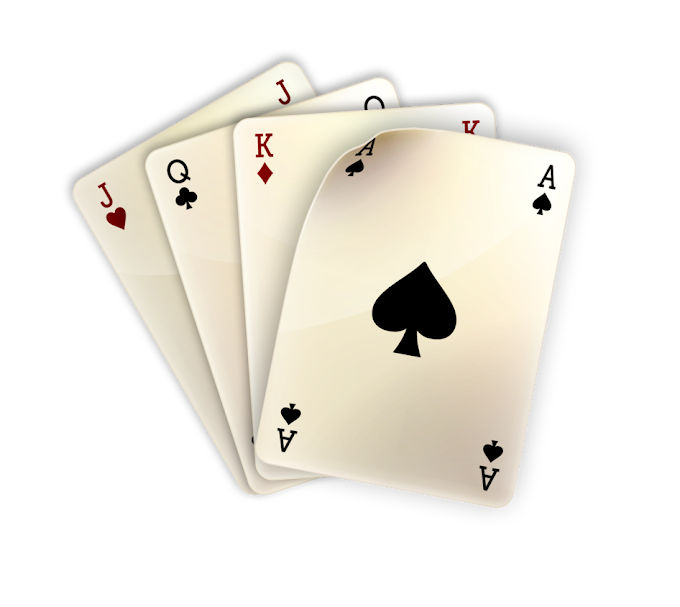Many players, especially us free online poker game players shy away from the "technical" side of the game, the working out of odds and such. After all it involves the dreaded "M" word (math).
Unfortunately the fact is that to succeed in poker this is a key part of the game that you must master, especially if you have any aspirations to play live money games.
The main problem for many free poker and money players is that it's so damn complicated. For example:
Suppose you have 8-7 and the Flop comes 5-6-A. You want to calculate the probability that you will hit your Straight later.
If you use a rigorous mathematical solution, you will come up with this:
The cards which will help you are the Four and the Nine. There are eight of them still remaining in the deck. The probability of your hitting them later is P + (1-P)Q, where P is the probability of hitting your hand on the Turn, and Q is the probability you will hit on the river. It is P + (1-P)Q because (1-P)Q is the probability that you will hit on the river if you don't complete your hand on the Turn.
Now here are the values for P and Q.
- P = 8 cards still on the deck to help you divided by 52-5 = 47 remaining cards = 8/47.
- Q = 8 cards still on the deck to help you, because you didn't complete on the Turn divided by 52-6 (because there are six cards already out, your hole cards and the Board) = 8/46.
The overall answer is 8/47 + (1 - 8/47)(8/46) = 0.170 + (0.829)(0.174) = 0.170 + 0.144 = 0.314 = 31%. You have a 31% chance of hitting your Straight later.
Ouch, that's fun and beyond a lot of us! However, in a table you usually do not have a calculator (and even if you do you still need to know what to input into it;).
And many poker players just know the outs, but not so much of basic probability theory. How is this? An out by the way is any unseen card that, if drawn, will improve your hand win chances. See for the full lowdown on outs.
So what is the fast, basic, easy way to work out odds?
It's the approximation formula: Taking the 8-7 hand above we:
- Divide 8 by 50, because 47 is close to 50, and get 0.16?
- Double it again and you get 0.32.
- This is a reliable estimate.
- After all, poker players, in games, do not need exact solutions; they need only a hint as to where they are standing.
- In this case "about 32%" is a good enough answer.
So, during the Flop, here is the approximation:
- Get the number of your outs, then multiply it by 4, then affix a percent sign.
- That is a reliable approximation percentage of your hitting the hand.
- During the Turn, if you still have outs, multiply it by 2, then affix a percent sign.
Unfortunately the fact is that to succeed in poker this is a key part of the game that you must master, especially if you have any aspirations to play live money games.
The main problem for many free poker and money players is that it's so damn complicated. For example:
Suppose you have 8-7 and the Flop comes 5-6-A. You want to calculate the probability that you will hit your Straight later.
If you use a rigorous mathematical solution, you will come up with this:
The cards which will help you are the Four and the Nine. There are eight of them still remaining in the deck. The probability of your hitting them later is P + (1-P)Q, where P is the probability of hitting your hand on the Turn, and Q is the probability you will hit on the river. It is P + (1-P)Q because (1-P)Q is the probability that you will hit on the river if you don't complete your hand on the Turn.
Now here are the values for P and Q.
- P = 8 cards still on the deck to help you divided by 52-5 = 47 remaining cards = 8/47.
- Q = 8 cards still on the deck to help you, because you didn't complete on the Turn divided by 52-6 (because there are six cards already out, your hole cards and the Board) = 8/46.
The overall answer is 8/47 + (1 - 8/47)(8/46) = 0.170 + (0.829)(0.174) = 0.170 + 0.144 = 0.314 = 31%. You have a 31% chance of hitting your Straight later.
Ouch, that's fun and beyond a lot of us! However, in a table you usually do not have a calculator (and even if you do you still need to know what to input into it;).
And many poker players just know the outs, but not so much of basic probability theory. How is this? An out by the way is any unseen card that, if drawn, will improve your hand win chances. See for the full lowdown on outs.
So what is the fast, basic, easy way to work out odds?
It's the approximation formula: Taking the 8-7 hand above we:
- Divide 8 by 50, because 47 is close to 50, and get 0.16?
- Double it again and you get 0.32.
- This is a reliable estimate.
- After all, poker players, in games, do not need exact solutions; they need only a hint as to where they are standing.
- In this case "about 32%" is a good enough answer.
So, during the Flop, here is the approximation:
- Get the number of your outs, then multiply it by 4, then affix a percent sign.
- That is a reliable approximation percentage of your hitting the hand.
- During the Turn, if you still have outs, multiply it by 2, then affix a percent sign.




0 Comments